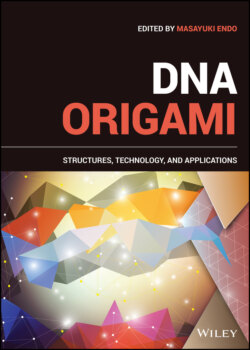Читать книгу DNA Origami - Группа авторов - Страница 18
1.5.2 Selective Placement of Functional Molecules and Proteins via Ligands
ОглавлениеProteins have been selectively attached to the DNA origami structures by conjugating ligands and aptamers to staple strands [39–42]. The combination of specific proteins and ligands, such as SNAP‐tag and Halo‐tag, was also used for the selective placement of fusion proteins on DNA origami (Figure 1.6b) [36]. Zn‐finger proteins are sequence‐selective DNA‐binding molecules, and the specific binding sequence can be determined by designing the amino acid sequences [43, 44]. Using DNA origami with five cavities, we introduced substrate DNA strands with recognition sequences into each cavity [45]. The Zn‐finger proteins directly bound to the cavity containing the target sequence with 50–80% yield. In addition, GFP‐fused Zn‐finger proteins retained sequence‐specific recognition ability, albeit with a lower binding affinity. These results show that proteins can be directly targeted to specific sites using sequence‐selective Zn‐finger proteins. In addition, a sequence‐specific DNA recognition molecule, pyrrole‐imidazole polyamide was able to recognize and bind to the target sequences on DNA origami [46, 47]. We used a DNA origami structure with five cavities, into which five different sequences were incorporated. We visualized the selective alkylation of a biotinylated polyamide to the target sequence with streptavidin labeling. Using this method, the polyamide was found to alkylate the target sequence in 88% yield by discriminating one‐base mismatches. Selective alkylation and subsequent streptavidin labeling revealed the sequence selectivity of the polyamide at the single‐molecule level.
